
Carmen K. Sisson/Shutterstock
Florida can be considered one of the top travel destinations in the United States. Many are drawn to the Sunshine State for its beautiful beaches, action-packed theme parks, and reliably warm weather, while others flock to visit friends and family. But something those visitors may not realize is that food is an integral part of Florida culture. Thanks to a diverse population, you can sample everything from Southern cuisine, to Latin American and Caribbean flavors. If you make the trek to Florida, there are some must-have foods you have to try to complete your Floridian experience.
As a born and raised Floridian, I have spent much of my life on the water, catching the fresh seafood that so many rave about. My family has been in Florida for more than 50 years, keeping us in tune with the local pulse beyond the tourist traps. Even though I have moved to the Western U.S. in recent years, I still spend a lot of time in my home state. These iconic Florida specialties are what I must have when I am in town, and what I dream about when I'm feeling a little homesick.
Stone crabs
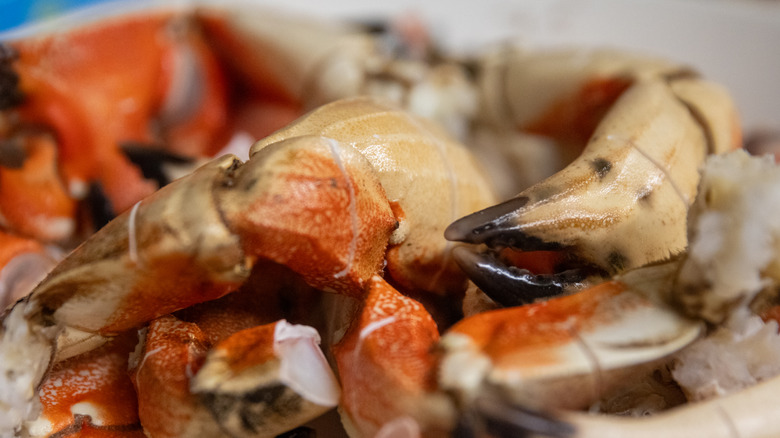
Lisatop/Getty Images
This is first on my list, especially when visiting Florida at my favorite time of year: stone crab season, which runs from October to May. Stone crabs are synonymous with Florida, as they can only be found in warmer waters, and are therefore plentiful on the state's Gulf and Atlantic coasts. In fact, 98% of stone crabs in the United States are sourced from Florida. What makes them different from, say, the Maryland Blue Crab is their especially large claws. Stone crabs' giant crusher claws contain sweet, delicate meat that you can dip in butter or mustard sauce.
There are plenty of ways to find and enjoy my favorite Florida seafood, including diving for stone crabs yourself. I grew up with my family doing this, but it is definitely not for the faint of heart, as it involves sticking your hands into dark, cramped places where the crabs hide. Nowadays, we use recreational stone crab traps for an easier method. Easier still, you can find fresh stone crab claws at local fish markets during the season. This can often be the best bang for your buck, as stone crab claws are priced by size and have typically already been cracked, which takes some of the hard work out of feasting. For a full dining experience, many seafood restaurants sell a complete stone crab dinner for a hefty price. Check out Joe's Stone Crab, whose cult following has made it one of the most successful restaurants in the U.S.
Key lime pie
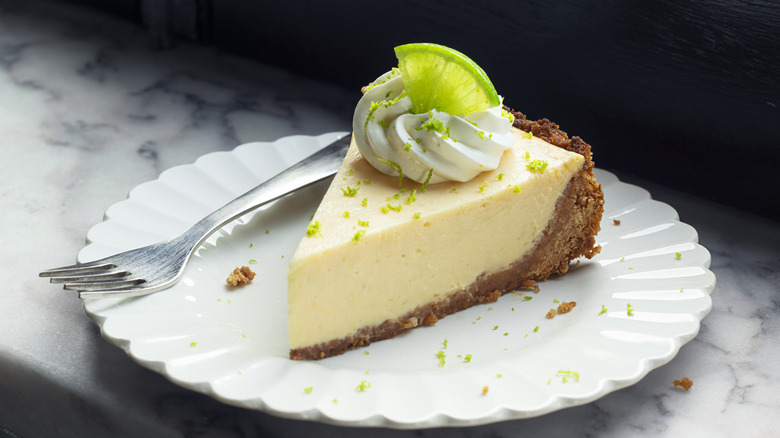
Viennetta/Getty Images
Though the origins of Key lime pie are up for debate, Key West lays claim to the famed dessert with recipes dating back to the early 1900s. Key lime pie is unlike any other citrus-forward pie, thanks to the tiny Key limes that pack a flavor punch. It can be topped with meringue or whipped cream, depending on the baker's choice. It traditionally has a graham cracker crust, though you may see some other tasty takes out there, and is one of my all-time favorite desserts to have when I'm home in Florida.
If you find yourself vacationing in Key West, head to Blue Heaven for its Key lime pie, which is certainly one of the best I have ever had. And while I know this will make the Key lime pie purists come after me, as a chocolate fiend, I really love the chocolate-dipped Key lime pie on a stick from Kermit's. It seems like kind of an odd pairing, but is somehow delicious!
You will find Key lime pie across the state in restaurants and bakeries, so you don't necessarily have to go all the way down South to get a good slice. You can even try making your own Key lime pie at home, using one of the many recipes out there. But to stay authentic, you should never use regular limes; it has to be Key limes or Key lime juice mixed with sweetened condensed milk.
Conch fritters
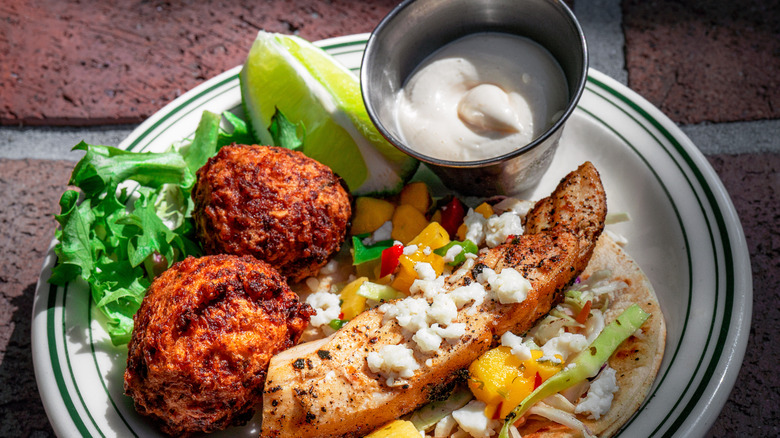
Ivana Larrosa/Shutterstock
If you are in the Florida Keys, which happens to be one of my favorite places on Earth, you cannot leave without trying conch. Pronounced "konk," it's a mollusk that hails from the Caribbean, Bermuda, and (of course) the Keys. In fact, the Queen Conch is so integral to Key West's identity that locals call it the Conch Republic. Each year, the area plays host to a New Year's Eve conch shell drop, and a conch shell blowing contest, where the beautiful, large shell is sounded like a trumpet at many resorts.
When fresh, conch doesn't have a particularly fishy taste or smell. A common way to use it is to fry it into tasty conch fritters, and eat it with a dipping sauce. This is typically served as an appetizer in local restaurants. However, conch can also be found in chowders, or steamed and added to salads. The versatile ingredient can even be turned into conch ceviche! If you want to try preparing it on your own, you should know that the key to cooking conch is to first tenderize it until it's soft, as the meat can be a little chewy otherwise.
Cuban food
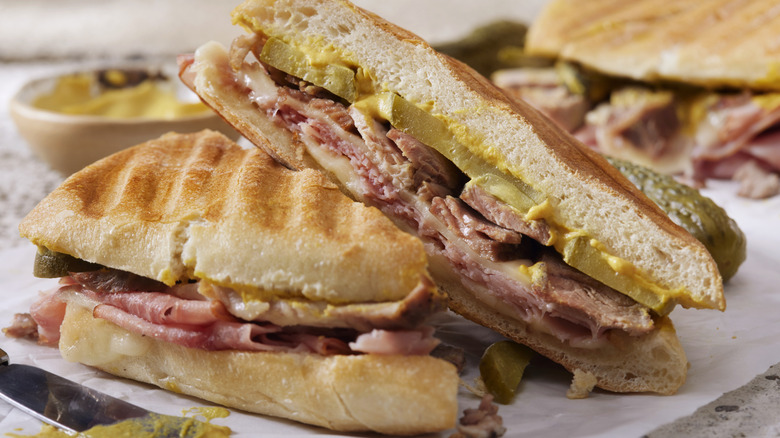
Lauripatterson/Getty Images
Florida offers diners a huge melting pot of different cuisines, and one of those is amazing and authentic Cuban food. Cuban cuisine is prevalent across the state, but it's especially abundant in the Tampa Bay area, and in South Florida. Here, the cuisine became particularly popular in the early 20th century, when Cuban immigrants brought their flavorful dishes as a taste of home.
In Florida, Cuban food can easily be enjoyed at every meal, beginning with breakfast and a cup of fresh Cuban coffee. I grew up smelling Cafe Bustelo, exclusively, brewing at my aunt's house in Tampa. Later on, I had some of the best coffee of my life in South Florida, at a Cuban restaurant's walk-up window. As Cuban coffee can be pretty strong on its own, I like to add hot steamed milk to make a Cortadito, and pair that with pastelitos de guayaba (guava and cheese pastries).
At lunchtime, get a Cuban sandwich made with roast pork, ham, Swiss cheese, pickles, and mustard on Cuban bread. My favorite is at Columbia Restaurant, always paired with a 1905 salad. Another classic sandwich is the medianoche, which includes sweet ham and mojo pork. Traditional Cuban picadillo, a dish featuring ground meat and tomatoes, is also a favorite recipe that I still make today for my family. Other must-try Cuban meals include ropa vieja, shredded beef stewed in tomato sauce, and arroz con pollo, a simple yet flavorful chicken and rice dish.
Smoked mullet
No, we aren't talking about the mullet hairstyle. Here, mullet is a type of fish brimming with old Florida flavors. It's plentiful along the bays and estuaries of the Gulf Coast, and often more reasonably priced than other seafood offerings. Fishing for mullet can be a fun family activity, as the schooled fish are caught in large quantities with a cast net. My kids love watching them jump across the water, especially during the fall months, when the fish are most active.
Mullet is a lean meat with a moderate flavor that can be fishier than that of other white fish. It can also lean a little oily, but that oiliness keeps it from drying out. Mullet can be prepared in multiple ways, but you will most commonly find it smoked or fried. The latter is traditionally served with grits or (my personal favorite) hush puppies.
You can smoke mullet yourself, as it only takes a couple of hours, but be sure to brine it first for optimal flavor. If you don't want to cook it yourself, you can totally order smoked mullet from a restaurant. Expect it to be served whole, butterflied without the head, leaving you to carefully pick the fish off the bone. My favorite preparation is mullet that has been smoked and removed from the bone to be made into a fish dip.
Gator tail
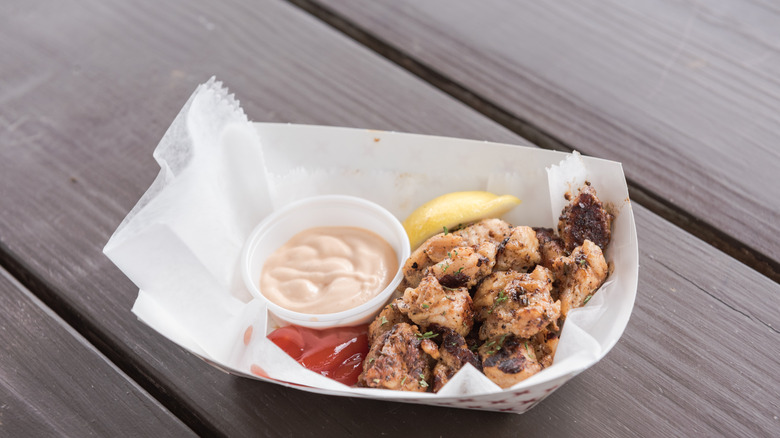
Sandra Foyt/Shutterstock
If you have been to an authentic Floridian restaurant, you've likely seen gator tail on the menu — and yes, it is actually an alligator tail. Alligators are plentiful in Florida, to the point where there is an alligator hunting season to pare down the population. Most likely, though, that gator tail you see on a restaurant menu is farm-raised.
I'm often asked by out-of-towners what alligator tastes like. True to its nickname, swamp chicken, the lean white meat really does taste like chicken. In fact, it can be used as a substitute for chicken, pork, or fish in recipes. As a high-protein, low-fat option, alligator meat also has similar health benefits.
When preparing alligator yourself, you'll find that the tail meat is pretty tender. But you may want to tenderize it a bit more, as the lean meat typically has a slightly tougher texture than chicken. In a restaurant, gator tail is most often fried into crisp little nuggets, and served as an appetizer with a dipping sauce akin to a remoulade. But gator's versatility easily takes it beyond the appetizer course. For example, I have had gator in homemade jambalaya at cookouts, and it's always delicious. Gator tail in any preparation is worth trying, in my opinion. When done right, it can complete the Florida dining experience.
Boiled peanuts
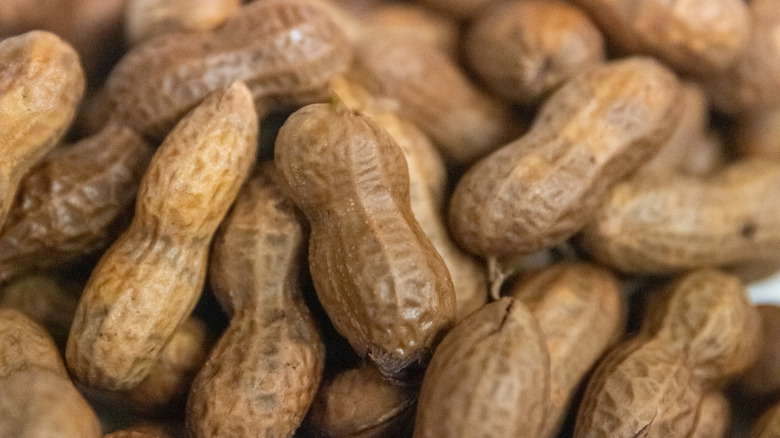
Lisatop/Getty Images
Boiled peanuts are exactly what they sound like: peanuts boiled in salted water, with the shell still on. (Of course, you will take them out of the shell before eating.) The boiling process gives the legumes a super soft texture, and a distinct flavor that can be considered an acquired taste.
Boiled peanuts have deep roots in the American South. The crop was first brought by enslaved people from Africa, who boiled surplus peanuts to share with their communities. Today, boiled peanuts are considered a Southern delicacy and, as part of the region, Florida proudly sells them at roadside stands, and even some gas stations. They're frequently available at backyard gatherings, and served as an appetizer at Southern-style restaurants.
There is something festive about standing around, peeling and eating boiled peanuts while chatting at a party. Because it takes some time to de-shell the peanuts, the snack doubles as a social activity. I have many childhood memories of getting a styrofoam cup of boiled peanuts from a vendor on the side of the road, or at the local gas station. Simply salted boiled peanuts are nostalgic, even as today's makers experiment with creative, modern takes. For fun, try yours with a little Cajun spice, some garlic, or even dill.
Ceviche
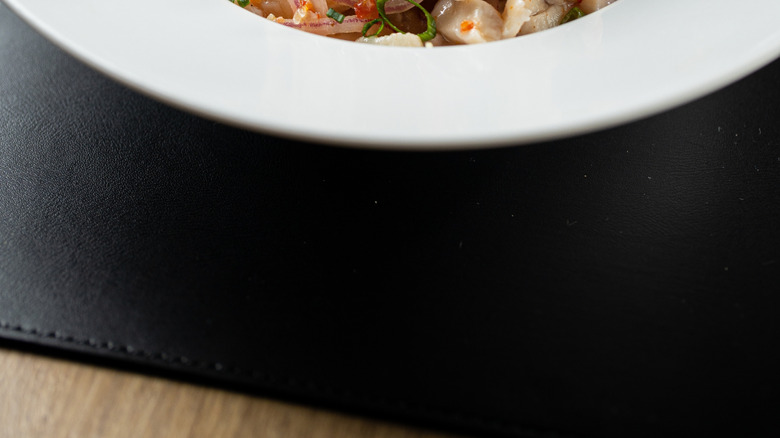
Paulo Zanella/Shutterstock
Though ceviche is technically a Peruvian dish, it has become particularly popular in coastal Florida, where the best fresh fish and citrus are combined to create a refreshing, delicious way to chill on a hot summer day. The best fish for ceviche is a classic white fish, but the dish can also be made with shellfish, like shrimp or conch. In ceviche, the fish is cut into bite-sized chunks and tossed with onions, tomatoes, and sometimes peppers or cilantro. It then "cooks" in the acid of citrus juice (probably Key lime, if you are in Florida). Some ceviche varieties will include a fruit like mango for added sweetness, avocado for a smooth texture, or diced jalapeño for spice. Even though no heat is used, because of the unique cooking method, ceviche is technically not raw. Regardless, you want to use the freshest, high-quality fish, as though you were eating it raw.
You can find ceviche at many seafood, Latin American, and Peruvian restaurants around the state of Florida, where it's often served with some sort of chip or cracker for dipping. My favorite ceviche is actually my dad's; he makes his with fresh snapper that he catches himself. While I love a super crispy homemade chip with my ceviche, at home, we use good ol' saltines as a vessel, if that's what we have on hand.
Florida spiny lobster
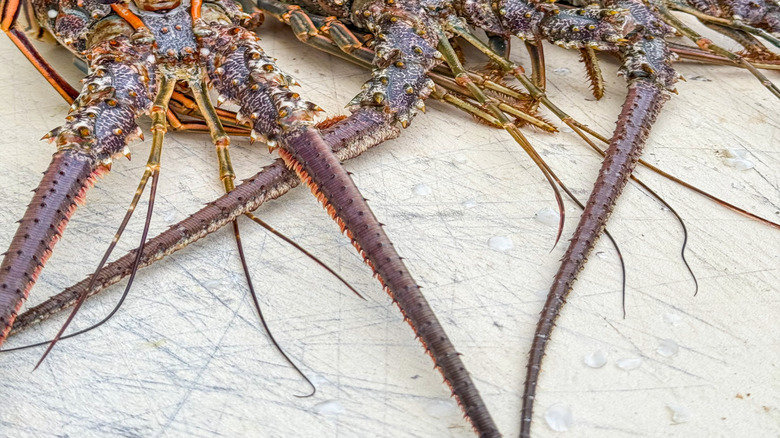
kabwise/Shutterstock
One Florida-specific seafood that's a must-have is the spiny lobster. Lobstering season runs from August through March, plus a mini season in the last week of July, and it's a rite of passage for residents of (and visitors to) the Florida Keys. Lobster fans head down in droves to dive for this prized crustacean, which hides in the coral rocks that give it the nickname "rock lobster." If you are picturing the typical Maine lobster with large claws, you will be in for a surprise. Instead of claws, Florida's spiny lobsters have large, spike-like antennae to scare off predators.
The meat of the spiny lobster is known to be sweet, but a bit saltier and firmer than the Maine lobster's. The unique texture makes it possible for spiny lobster to be thrown on the grill, and this is a common preparation. I personally love my Florida spiny lobster tail simply broiled with a side of melted butter to dip. In restaurants, you will typically be served the spiny lobster tail instead of a whole lobster, like you would at a New England lobster boil. That doesn't mean the tail is the only part of the spiny lobster that can be consumed, though it is where the majority of the meat resides. Some like to also boil the antennas and crack them open like snow crab legs, but this is probably only worth the effort if you have very large spiny lobsters.
Oranges
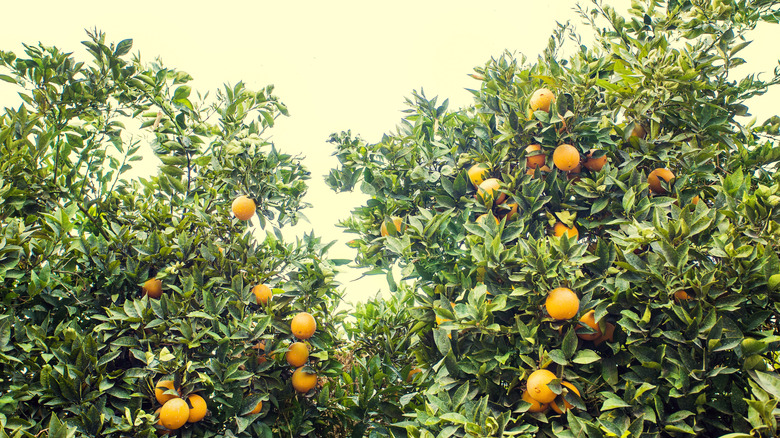
Yobro10/Getty Images
Though the citrus industry has taken a hit in recent years due to hurricanes and citrus greening disease, Florida is still known for its citrus crops. Citrus growing in Florida dates back to the 1500s, and the fruits have always flourished in the state's warm, non-freezing climate. Of these, Floridians probably love oranges the best. Oranges and orange juice are Florida's official state fruit and beverage, respectively, and the orange blossom is the state flower. Florida's official interstate welcome centers even offer free samples of orange juice to those driving across state lines. But grapefruit, tangerines, and mandarins are also grown here, and are also pretty tasty.
Florida oranges can be an entire tourist experience, especially in Polk County (the top citrus provider) and around Central Florida. The area is filled with orange-centric attractions, like orchards where visitors can pick their own citrus. Many locations also offer sweet treats, like the vanilla- and orange-flavored ice cream swirls that make up a core memory of my childhood in the Florida citrus groves.
If you aren't a big citrus fan, don't worry. Try strawberries instead, especially in the spring, when the state celebrates Plant City's strawberry culture with the Florida Strawberry Festival that lasts nearly two weeks long.
Greek food

James Kirkikis/Shutterstock
The coastal town of Tarpon Springs, Florida, just north of Tampa, is a charming food mecca home to some of the best Greek food in America. The place has been nicknamed Little Greece, and is also the sponge capital of the world, due to its abundance of natural sponges. This last fact is what first put the small town on the map in 1905, when Greek immigrants arrived to harvest the sponges. Its popularity grew as more immigrants arrived, each bringing the delicious foods of their home lands, as well as their traditions and customs.
Tarpon Springs is now a lively coastal town that offers numerous authentic Greek restaurants, bakeries, fresh seafood, famous sponge docks, and a historic shopping district that makes it a unique travel destination. When we get a craving for Greek food, my family will road trip for over an hour to Hellas Restaurant & Bakery for moussaka (a layered, lasagna-style casserole of eggplant and meat) along with spanakopita (spinach and phyllo pie) and baklava (a honey phyllo dough pastry) for dessert. You also can't go wrong with a gyro for a handheld meal on-the-go.
Swamp cabbage
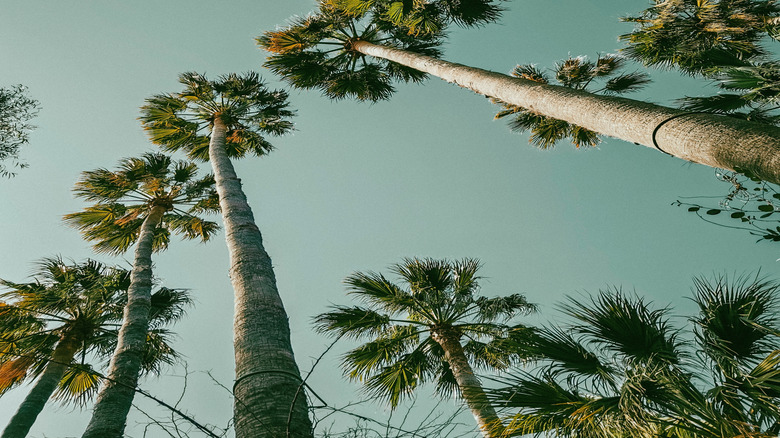
Ender BAYINDIR/Shutterstock
Unless you have spent some time in the state's more rural areas, you aren't likely to be familiar with this dish. But swamp cabbage has deep Florida roots. In fact, when I discussed this article with my husband, a fellow Florida native, this dish was the first one he mentioned.
It's important to note that swamp cabbage isn't actually cabbage at all. It is the heart of the sabal palm, which is Florida's official state tree, peeled and cut into rings that resemble cabbage. Boiled, stewed, or even eaten raw, Native Americans in Florida used this cabbage palm as a common food source. Today, it is often braised in liquid with a ham hock or pieces of smoked meat, to make it stew-like. While this dish isn't as widely served across the state as others on this list, it can be found in restaurants that specialize in old Florida cuisine, and there is an entire festival dedicated to the swamp cabbage held in LaBelle, Florida each February. At other times of year, you may be lucky enough to sample some homemade swamp cabbage. Otherwise, the hearts of palm found at your local grocery store can make a valid, though inauthentic, substitution.



